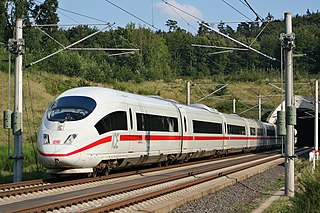
A multiple-unit train or simply multiple unit (MU) is a self-propelled train composed of one or more carriages joined, which when coupled to another multiple unit can be controlled by a single driver, with multiple-unit train control.

A conductor or guard is a train crew member responsible for operational and safety duties that do not involve actual operation of the train/locomotive. The conductor title is most common in North American railway operations, but the role is common worldwide under various job titles. In Commonwealth English, a conductor is also known as guard or train manager.

VR-Group Plc, commonly known as VR, is a government-owned railway company in Finland. VR's most important function is the operation of Finland's passenger rail services with 250 long-distance and 800 commuter rail services every day. With 7,500 employees and net sales of €1,251 million in 2017, VR is one of the most significant operators in the Finnish public transport market area.

SJ is a government-owned passenger train operator in Sweden. SJ was created in 2001, out of the public transport division of Statens Järnvägar, when the former government agency was divided into six separate government-owned limited companies. In 2018, SJ carried 31.8 million passengers.

X 2000, also called SJ X2 or simply as X2, is an electric high-speed tilting train operated by SJ in Sweden. It was constructed by Kalmar Verkstad in Kalmar, Sweden and launched in 1990 as a first-class only train with a meal included in the ticket price, and free use of the train's fax machine. There is a bistro on board that serves snack bar-style dishes. From 1995 second class was introduced. All trains are equipped with Wi-Fi for passenger access to the Internet and were repainted grey as of 2005. The trains also have electric power supply sockets at all seats in both first and second class. The trains have been fitted with repeaters to improve mobile phone reception.
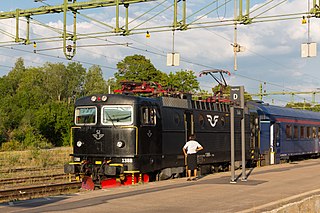
The Rc class is the most used electric locomotive in Sweden. Rc is a universal locomotive used both in freight and passenger trains. The largest operator is Green Cargo, although SJ, Tågab, Hector Rail and the Swedish Transport Administration operate it as well. Previous operators include Veolia Transport.

The term cab forward locomotive refers to various rail and road vehicle designs that place the driver's compartment substantially farther towards the front than is common practice.

The DSB Class MF is a Danish-built high-comfort medium/long distance diesel multiple-unit train. The sets were built by ABB Scandia in Randers. This train model has been operating in Denmark and Sweden since 1990 and was previously operated in Israel. The name IC3 indicates simply that it is a three-carriage InterCity trainset.
PKP classification system is a system of assigning letters and numbers to series and individual locomotives used by the PKP - Polish national railroad operator.

ET22 is a Polish six-axle electric freight locomotive built by Pafawag from 1969 to 1989. Factory designation is 201E. With 1183 units, it is one of the most numerous standard gauge electric locomotive built in Europe. Further 23 units were built for Morocco as E-1000 class.

EN57 is an electric multiple unit used by the Polish railway operator (PKP). It was built for suburban and long-distance services. Presently it is used by Polregio, SKM Trójmiasto, Koleje Dolnośląskie, Koleje Śląskie, Koleje Wielkopolskie and Koleje Mazowieckie companies in Poland.
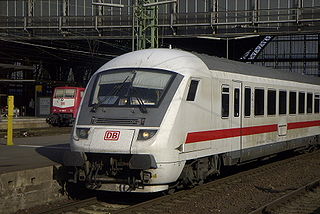
A control car, cab car, control trailer, or driving trailer is a non-powered rail vehicle from which a train can be operated. As dedicated vehicles or regular passenger cars, they have one or two driver compartments with all the controls and gauges required to remotely operate the locomotive, including exterior locomotive equipment such as horns, bells, ploughs, and lights. They also have communications and safety systems such as GSM-R or European Train Control System (ETCS). Control cars enable push-pull operation when located on the end of a train opposite its locomotive by allowing the train to reverse direction at a terminus without moving the locomotive or turning the train around.

Iore, often stylized IORE, is a class of 34 electric locomotives built by Adtranz and its successor Bombardier Transportation for the Swedish mining company LKAB's railway division Malmtrafik. The class is a variation of Adtranz's Octeon modular product platform, thus related to Bombardier's later TRAXX platform. The locomotives are considered to be one of the most powerful locomotives and haul iron ore freight trains on the Iron Ore Line and Ofoten Line in Sweden and Norway, respectively. The 8,600-tonne 68-car trains are hauled by two single-ended Co′Co′ locomotives, each with a power output of 5,400 kW (7,200 hp). Each operates with 600 kilonewtons tractive effort and has a maximum speed of 80 km/h (50 mph). Delivery of the first series of 18 locomotives was made from 2000 to 2004, and they replaced some of the aging Dm3 and El 15 units. In 2007, eight more vehicles were ordered, with production to be completed by 2011, by which time, another four double units were ordered. These units were scheduled to be delivered from 2013 to 2014.

Trainkos, is the national railway company of Kosovo. It was originally formed as the Kosovo Railways J.S.C UNMIK Railways from the lines of the former Yugoslav Railways that lie on Kosovar territory. In 2011, the company was split into two public companies called Trainkos and Infrakos, the latter responsible for rail maintenance.
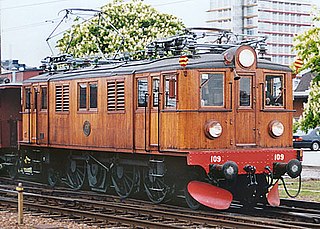
D is a series of locomotives used by Swedish State Railways. 333 units were built by ASEA between 1925-43. It was used for both passenger and freight trains until it was taken out of service in 1988.
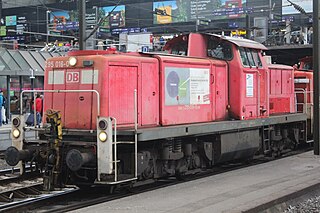
The DB Class V90 locomotive is a German road switcher diesel-hydraulic locomotive for shunting and freight hauling.

The Electroputere LE 5100, otherwise known as CFR Class 40/41/42, is a family of electric locomotives built for the Romanian Railways (CFR) for use on the Romanian electrified network. Over 1000 Class 40s were constructed, based on the SJ Rb, by Electroputere (EP) under ASEA license in EPs Craiova Works from 1967 to 1991.

The A class of the Swedish State Railways (SJ) was a type of steam locomotive built in 1906–1909 for hauling mainline express trains. The 26 locomotives were built to replace older types that could not cope with the increasingly heavy express trains, but soon became insufficient themselves. They were relegated to less important passenger trains, and five were transferred to then-independent Ostkustbanan (OKB) in the 1920s, but returned when that company was nationalized in 1933.
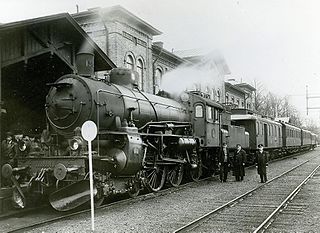
The B class of the Swedish State Railways (SJ) was a type of steam locomotive for mixed traffic, introduced in 1909. 96 locomotives were built for SJ by between 1909 and 1919. The 4-6-0 B class was part of the development of modern superheated locomotives that had begun with the A class in 1906. Intended for fast freight trains and heavy stopping passenger trains, they proved to be highly useful in all types of traffic, and remained in use until the end of steam operations in Sweden.

The E, E2 and E5 classes of the Swedish State Railways (SJ) were three closely related types of steam locomotives. The E class 0-8-0 locomotives were part of the development of modern superheated types that had begun with the A class in 1906, and were intended for both mixed traffic in Norrland and heavy freight trains in southern Sweden. Many of them were rebuilt to the 2-8-0 E2 class between 1935 and 1951, enabling a speed increase from 65 kilometres per hour (40 mph) to 70 km/h (43 mph). Three E class locomotives built for private railways became known as the E5 class following nationalization, as they were slightly heavier than the ones built for SJ.



















